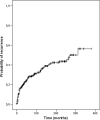Predictors for outcome of failure of balloon dilatation in patients with achalasia
- PMID: 21068135
- PMCID: PMC3002841
- DOI: 10.1136/gut.2010.211409
Predictors for outcome of failure of balloon dilatation in patients with achalasia
Abstract
Background: Pneumatic balloon dilatation (PD) is a regular treatment modality for achalasia. The reported success rates of PD vary. Recurrent symptoms often require repeated PD or surgery.
Objective: To identify predicting factors for symptom recurrence requiring repeated treatment.
Methods: Between 1974 and 2006, 336 patients were treated with PD and included in this longitudinal cohort study. The median follow-up was 129 months (range 1-378). Recurrence of achalasia was defined as symptom recurrence in combination with increased lower oesophageal sphincter (LOS) pressure on manometry, requiring repeated treatment. Patient characteristics, results of timed barium oesophagram and manometry as well as baseline PD characteristics were evaluated as predictors of disease recurrence with Kaplan-Meier curves and Cox regression analysis.
Results: 111 patients had symptom recurrence requiring repeated treatment. Symptoms recurred after a mean follow-up of 51 months (range 1-348). High recurrence percentages were found in patients younger than 21 years in whom the 5 and 10-year risks of recurrence were 64% and 72%, respectively. These risks were respectively 28% and 36% in patients with classic achalasia, respectively 48% and 60% in patients without complete obliteration of the balloon's waist during PD and respectively 25% and 33% in patients with a LOS pressure greater than 10 mm Hg at 3 months post-dilatation. These four predictors remained statistically significant in a multivariable Cox analysis.
Conclusion: Although PD is an effective primary treatment in patients with primary achalasia, patients are at risk of recurrent disease, with this risk increasing during long-term follow-up. Young age at presentation, classic achalasia, high LOS pressure 3 months after PD and incomplete obliteration of the balloon's waist during PD are the most important predicting factors for the need for repeated treatment during follow-up. Patients who meet one or more of these characteristics may be considered earlier for alternative treatment, such as surgery.
Conflict of interest statement
Figures



References
-
- Richter JE. Oesophageal motility disorders. Lancet 2001;358:823–8 - PubMed
-
- Park W, Vaezi MF. Etiology and pathogenesis of achalasia: the current understanding. Am J Gastroenterol 2005;100:1404–14 - PubMed
-
- Lake JM, Wong RK. Review article: the management of achalasia – a comparison of different treatment modalities. Aliment Pharmacol Ther 2006;24:909–18 - PubMed
-
- Karamanolis G, Sgouros S, Karatzias G, et al. Long-term outcome of pneumatic dilation in the treatment of achalasia. Am J Gastroenterol 2005;100:270–4 - PubMed
-
- Zerbib F, Thetiot V, Richy F, et al. Repeated pneumatic dilations as long-term maintenance therapy for esophageal achalasia. Am J Gastroenterol 2006;101:692–7 - PubMed
MeSH terms
LinkOut - more resources
Full Text Sources
Other Literature Sources
